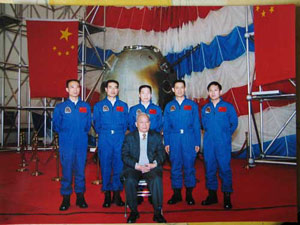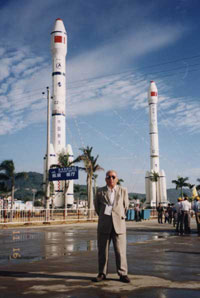Source: CCTV.com
08-01-2006 17:22

Liang Sili is a specialist in missile control systems and member of the Chinese Academy of Sciences. As a pioneer in the aerospace industry, he has dedicated his life to the development of China’s aerospace industry with a spirit of self-reliance, hard work, team spirit, and selfless devotion. Youngest son of the renowned thinker Liang Qichao, Liang Sili has inherited his father’s spirit of patriotism. His goal in life is to help build a powerful China, a China that will not be bullied by anyone.
In 1948, after eight years of studying in the United States, Liang Sili came back to China. The spring of 1956 was a turning point in his life when he joined the Fifth Academy of China’s National Defense Ministry, which is recognized as the seed of China’s aerospace industry. In the 1950s, Liang Sili saw China’s aerospace start from scratch. At first, the former Soviet Union provided aides to China. But as the relationship between the two countries deteriorated, the Soviet Union stopped helping China and finally broke the cooperation contract. Thereafter, China adopted a policy of self-reliance. In 1960, China successfully launched a missile, which is a copy from the Soviet Union. In 1962, Liang Sili and his colleagues were ready to launch the first missile designed and created by China. At that time, Liang’s wife was to give birth to their third child. Liang Sili decided to name the unborn child in honor of the new project. He said if the child were a boy, his name would be “Kai”; if a girl, her name would be “Xuan”. “Kai Xuan” in Chinese means victorious return. But the launching failed. Liang says humorously that although he was not a victor, he returned. It turned out later that the baby was a girl, so she was named Liang Xuan.

Liang Sili and his colleagues were not defeated by this failure. Instead, they worked harder. In 1964, China launched its first atomic bomb. Two years later in 1966, China successfully combined the atomic bomb with a missile, which means China not only had a bullet but also had a pistol. In 1967, China shocked the world again by detonating a hydrogen bomb. In 1970, China became the fifth country able to launch a man-made satellite. And the weight of the earth satellite Dong-Fang-Hong 1 exceeded the sum of the four satellites earlier launched by the Soviet Union, the US, France and Japan. In 1980s, with the implementation of opening-up and reform policy, Liang Sili saw a rapid growth in China’s space industry. He participated in the successful missile launch toward the Pacific Ocean and witnessed China’s Long March rockets entering the international satellite launching market. From 1996 to 2004, China has conducted more than 40 successful launches with no failure. Now China is the world’s third country to succeed in manned space flight since China’s spacecraft ShenZhou V successfully took Taikonaut Yang Liwei into space and back to the earth.
As a scientist, Liang Sili also spends a lot of time and energy on popularizing aerospace science. In the Up-Close studio, audience members were welcomed to participate in a game testing their space knowledge and learn how space science applies to our daily lives. Want to know more about China’s aerospace history and test your own knowledge of space science? Watch our show on TV or log onto our website to see our interview with China’s aerospace pioneer Liang Sili.--Written By Chai Haoran
Editor:Chen

